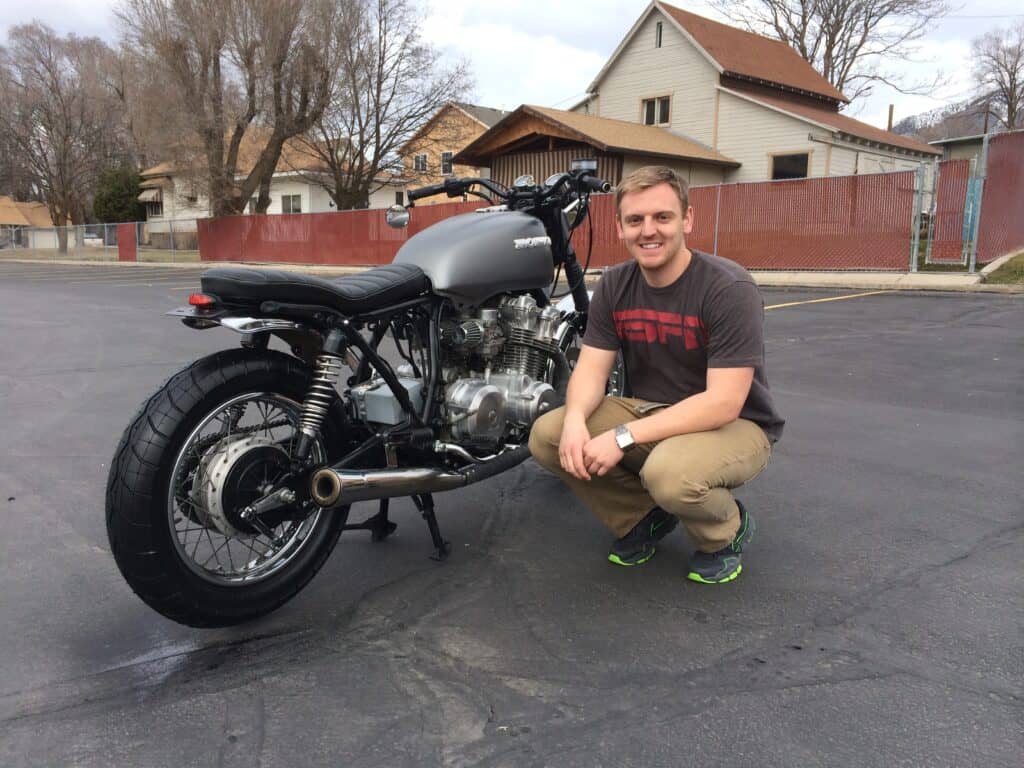
If you’re new to motorcycle riding, or you’re a seasoned motorcycle rider but want to increase your riding skills, you’ve come to the right place!
I rode dirt bikes all while growing up in Moab, Utah. It wasn’t until I got to college that I officially got my motorcycle license; I learned a thing or two during the process and I’m here to share those experiences. I’ve compiled a list of helpful tips and tricks for new motorcycle riders that can guarantee a smooth transition into this new skill.
Use Both Brakes
Braking is an essential part of riding a motorcycle. If you don’t know how to do it properly, that could be dangerous and even life-threatening.
If you are to apply just the front brakes, it will ultimately help you stop sooner than just applying the back brakes. However, if just the front brakes are applied you run the risk of going over the handlebars.
Using both brakes evenly will give you a much smoother and quicker stop. Each motorcycle is different in regards to how much pressure is needed to make a smooth stop using both brakes, so make sure you practice with your motorcycle before you take it out for a spin.
Check All Fluids Regularly
It’s important you make it a point to regularly check your motorcycle fluids. Such fluids include crankcase oil, engine oil, and brake fluid.
I usually check all of these fluids every time I go to the gas station. Some may think this is too much, but too many times I have thought I had enough fluid and got myself in a crunch because I didn’t check and top them off.
Be sure to check the crankcase and engine oil at running temperature so you can get an accurate reading. Check your brake fluid level in the master cylinder when the bike is cooled down.
Regularly Change Your Oil
You’d be surprised at how many people are aware of this basic concept of maintenance but don’t actually execute it.
Be sure to change your motorcycle oil every 3,000-5,000 miles, or every six months (whichever comes first). Don’t assume that your oil is good after a year because you didn’t ride your bike much, engine oil does get old and doesn’t work as well over time. If you’re unsure what type of oil your motorcycle needs, see my helpful guide here.
Know How To Ride With A Passenger
Even if you don’t think you’ll ever ride your motorcycle with a passenger, it’s important you learn how to do it anyway. Riding with a passenger is a whole different game compared to riding by yourself.
I encourage you to learn how to ride with a passenger because of potential emergencies. If you’re ever stuck in a bind and are forced to take an additional rider with you on your motorcycle, you’ll be more prepared. You never want to risk the chance of injuring someone else because you didn’t know how to ride with their extra weight in the back.
Know Hand Signals
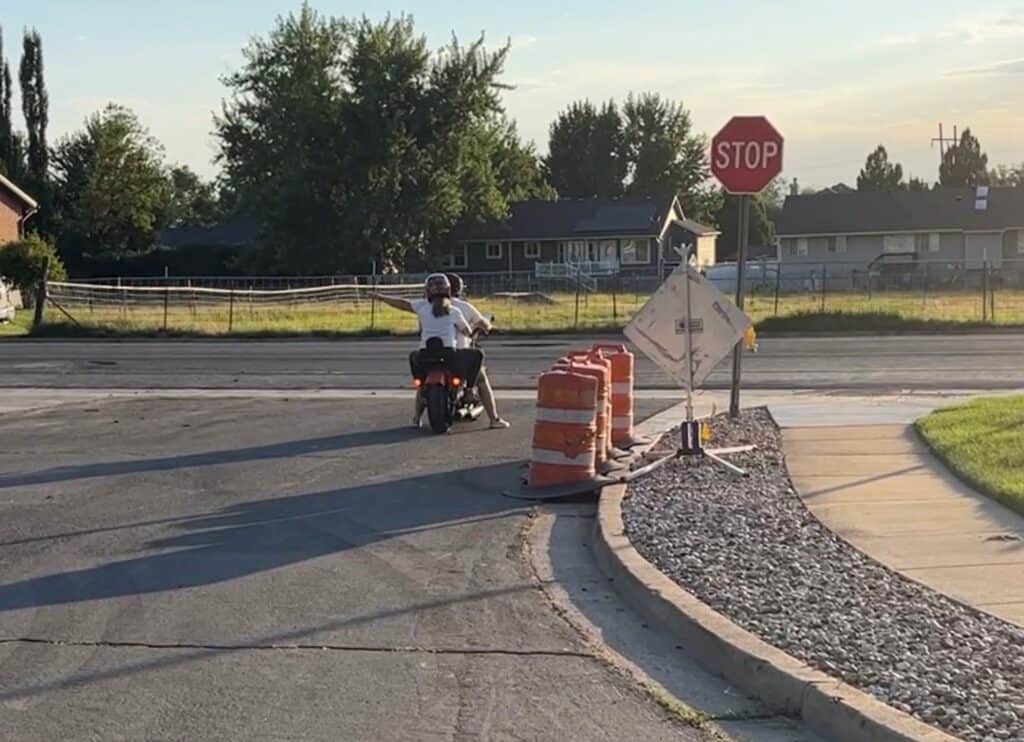
If you’re wanting to become a motorcycle rider, it’s a must to learn hand signals. These are used for communicating with drivers around you about what you’re intending to do while riding.
You generally aren’t required to use hand signals, but it’s good to know in case other motorcycle riders are trying to communicate with you. It’s also helpful to use in case your blinkers and lights go out.
To learn about the most important and basic hand signals motorcyclists use, check out this chart from ktsro.org.
Know Your State’s Laws
Understanding the motorcycle laws of the state you live in could make the difference between being law abiding or getting a $500 ticket.
Also, be mindful of each state’s laws if you plan on doing a long road trip on your motorcycle; the second you cross over a state line you’re in a whole different realm of laws.
For example, if you live in Texas, people 20 years old or older don’t need to wear a helmet. So at your age you may be used to not wearing one. Once you cross the state line into Louisiana, you could be getting a hefty fine from that state because Louisiana requires all riders to wear a helmet, no matter what age.
Always Wear a Helmet
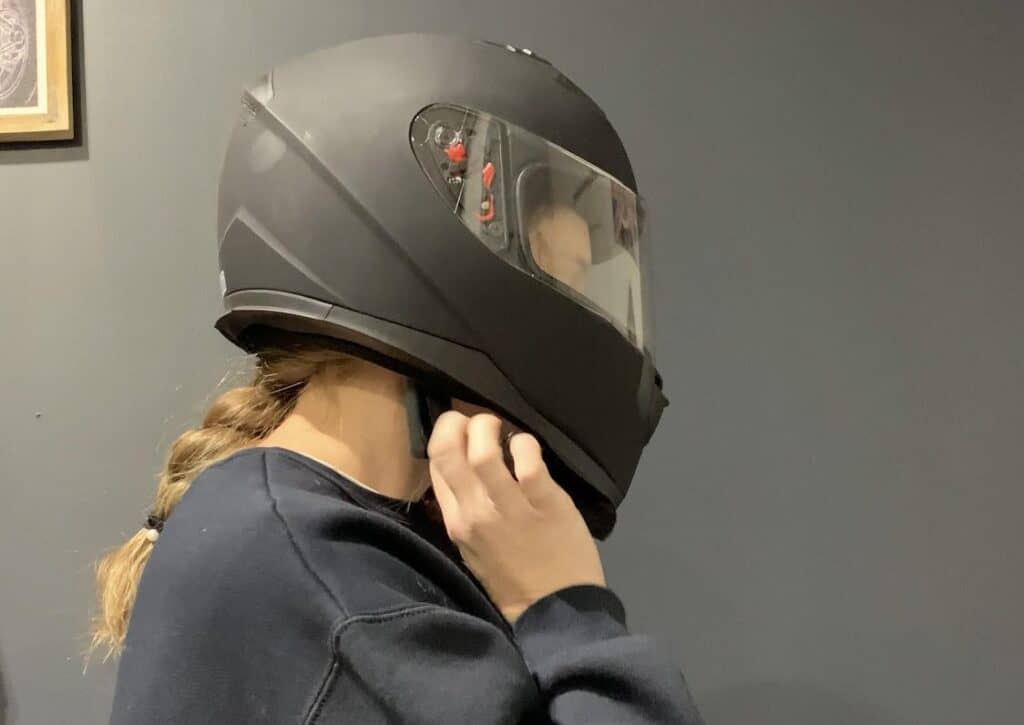
Whether or not your state requires you to wear a helmet, you should always wear one anyway (see the helmet I recommend in my list of suggested gear found here). There are times that it’s extremely tempting to not wear a helmet, especially when you know you’re just riding down the road for a quick spin. But it only takes a second to get into an accident and a quick trip down the road has a lot of seconds.
Iihs.org stated that “because serious head injury is common among fatally injured motorcyclists, helmet use is important. Helmets are about 37 percent effective in preventing motorcycle deaths and about 67 percent effective in preventing brain injuries.”
Wear The Right Shoes
Wearing the wrong shoes while riding your motorcycle can be dangerous. Your feet are next to a pair of tires that are spinning thousands of times a minute, not to mention the extremely hot exhaust pipes just inches away.
As a new rider, you should invest in a decent pair of riding boots. You don’t need to break the bank to get some, just make sure you get some that are made of thick material that will cover above your ankles. This will prevent any possible feet injury.
Wear Long Pants
The most protective type of pants you should wear while riding a motorcycle are leather pants, but most people never end up doing that (and to be completely honest, I really hate how they feel). Plan on at least wearing a good thick set of denim jeans to protect your legs.
Know How To Do a Hard Brake Safely
Riding a motorcycle is really fun, but it also holds some dangers. You could be the safest rider out there, but you can’t control the other drivers around you.
If you’re new to motorcycle riding, assume that at some point in your life you will have to do a really hard brake on your motorcycle. Practice how to safely do a hard brake before you actually have to do it to save your life. It really could be a matter of life or death. Practicing this can help you understand how your specific motorcycle works in a scenario like this.
Know How To Safely Swerve
While riding a motorcycle, there will be times when something unexpected appears in your path and you have .5 seconds to decide how you’re going to get around it safely.
There is an art to “swerving” on a motorcycle, and it’s definitely a good idea to get used to how your motorcycle handles it in a controlled environment. That way you’ll be ready in case you need to use the skill.
Know The Forecast
Any time before you go out for a ride on your motorcycle, take a quick look at the weather for the day to make sure you are not caught in any weather you’re not comfortable with.
If you plan on taking a long road trip on your motorcycle, check the forecast for the next few days. If you have to continue riding, make sure you’re prepared with the proper gear to keep you comfortable during inclement weather.
Assume No One Can See You
If you’re new to motorcycle riding, always assume that other drivers around you cannot see you and drive accordingly. Unless they’re motorcycle riders themselves, most other drivers don’t think to look for motorcycles on the road.
Avoid riding in people’s blind spots, stay a good distance away from the vehicle you’re riding behind, and always keep checking your mirrors at what the car behind you is doing.
Never Stay In The Middle Lane
If you’re riding on the freeway, a good rule of thumb to remember is to never stay riding in any of the middle lanes. Always stay in the far right lane or the far left lane.
Granted, you’ll need to use the middle lane sometimes to get around. But keeping close to the outside lanes gives you a good safety net in case you need to pull over. Pulling over in an emergency on a motorcycle is quite tricky if you’re stuck in the middle lane (it’s happened to me several times!).
Never Ride Behind Loaded Trucks

I’ve lived in several places that are considered “country,” and with that came a lot of truck drivers who thought they didn’t need to strap down their stuff in the bed of their truck. I’ve ridden my motorcycle behind these trucks and several times items were thrown or bumped out of them and headed right towards me.
Especially as a new motorcycle rider, never stay behind a truck carrying a load even if it seems they have everything secured and strapped in. Maneuver yourself somewhere else and don’t risk the chance of something from that load flying out towards you.
Have a Plan In Case You’re Stranded
Whether you have a brand new motorcycle or an old one, you should assume that at some point it will break down and that it will break down at a very inconvenient time and place.
Hopefully you will never have to experience this, but having a back-up plan can help tremendously in case you are caught in this situation.
Have a plan of who will come get you in case you do break down. Do you have a trailer? If not, do you have a neighbor or friend who has one you could call? Do you have towing insurance? Or are you willing to pay for a towing company to come get you?
If you plan to use the trailer of a colleague along with their assistance, be sure to talk to them beforehand and let them know you plan on asking them in case you get stranded.
Always Carry Important Paperwork
Your motorcycle registration, driver’s license, and motorcycle insurance cards are items you always need to have with you every time you go for a ride on your motorcycle.
The one time you don’t have your important paperwork with you is the day you’ll get pulled over. Consider some ways of storing your registration and other paperwork on your motorcycle so you won’t be left with nothing to give to the police officer. You can read my article about creative ways to store your registration.
Know How To Do a Push Start
A dead motorcycle battery is always annoying, especially if you have somewhere you need to be. But did you know that you can still start your motorcycle even with a dead battery?
A motorcycle battery is used to start the motorcycle and has little use after that. The stator is what keeps the motorcycle running. As a new motorcycle rider, it’s a good idea to learn how to start your motorcycle by doing a rolling start in case you find yourself in a dead battery situation.
The whole premise behind a push start is getting the motorcycle moving quickly and then let out the clutch in first gear and the compression from the cylinders will ignite the gas and start the bike. I’ve done it loads of times and it works! See my article here for more details on how to push start a motorcycle.
Routinely Check Tire Pressure
Tires are a component on your motorcycle that you do not want to neglect. They are what protects you from the road you’re riding on. If you take good care of your tires, they’ll take good care of you.
Have a tire pressure gauge handy and routinely check your tire pressure, about once a week if you ride fairly often. The recommended PSI for your specific tires should be stated on the side of your tires. Take note of what the different PSI should be between cold and hot weather.
Routinely Check Chain Tension
Your motorcycle’s chain health is important because without it, you don’t have any power coming from your back wheel.
There are tools made specifically to check the tension of your chain. Generally, a chain’s tension should be between 30 – 40 mm of slack, but check your owner’s manual to see what specific slack your motorcycle chain should have.
Too tight of a chain can potentially break it and too loose of a chain can make it fall off altogether. While you’re at it, make sure the chain is lubricated to prevent further problems. If you’re curious about what happens when a motorcycle chain breaks, check out an article I wrote by clicking here.
Use The Right Fuel
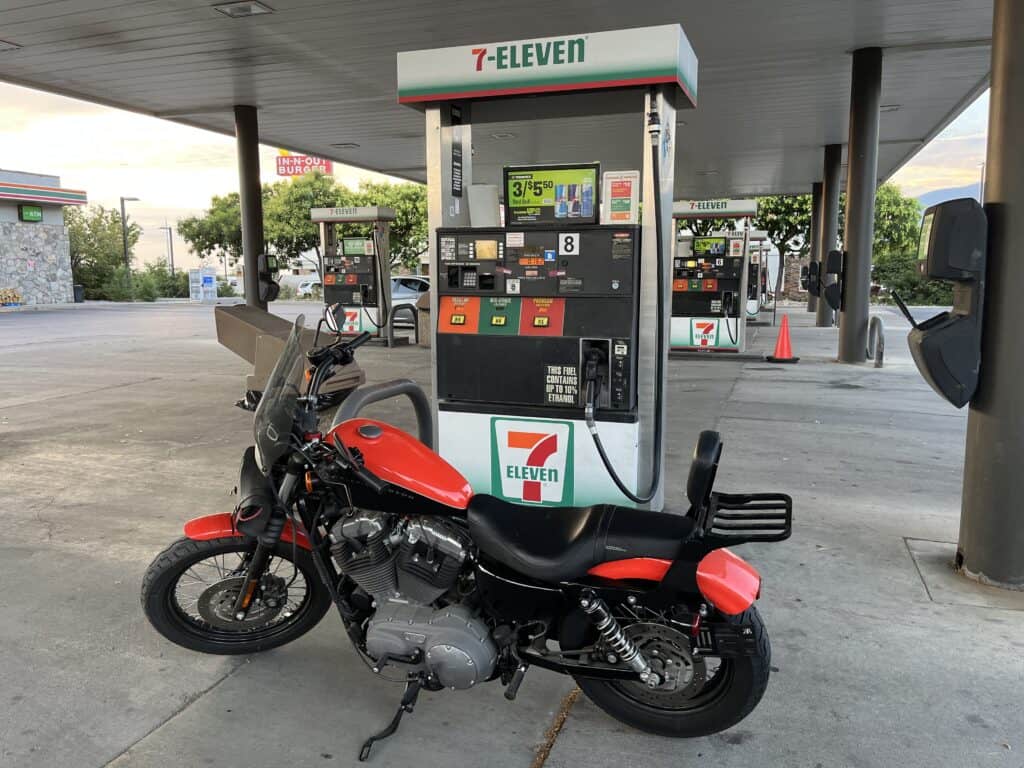
If you have a motorcycle that has a carburetor, you should never use gas that has ethanol in it. This is because ethanol is essentially a water absorber and can be potentially corrosive to your fuel system.
You don’t need to worry too much about this if you have a fuel injection system since ethanol gas doesn’t cause much problems with them. Here is my guide to help you decide the best type of fuel to use for your motorcycle.
Know Distances Between Gas Stations
If you plan on taking a long trip on your motorcycle, it is wise to know the distance between gas stations as you go, especially if you’re riding anywhere in the west or midwest. You do not want to be stranded in the middle of nowhere with no gas, especially if you’re alone.
Using an app like GasBuddy will help you know exactly what gas station is where and their exact distance from your location. This app can also tell you who has the cheapest gas and what facilities each gas station has.
Get Familiar With Your Motorcycle Components
Sure, you may know where your clutch, throttle, blinker switch, and brakes are, but do you know where your main fuse, cylinder head, airbox, wiring harness, and carburetor is?
As a new motorcycle rider, knowing more than just the location of your motorcycle’s basic parts can be very beneficial. Try to become familiar with other parts of your motorcycle and what their function is. This will help you better understand how your motorcycle works and ultimately help you become a better rider.
Store Your Motorcycle Appropriately
Too many times I have seen a motorcycle sitting outside in the elements with no cover or source of protection. It’s not good for a motorcycle to be left out in the open for long periods of time. Find a place to store it so it is out of the way from any harm or damage.
It is possible to store a motorcycle outside if needed, but proper storage procedures should be taken. See my guide here to learn how to store a motorcycle outside.
Run Your Motorcycle Occasionally During Winter
Some of you are probably living in climates where it gets really cold in the winter, thus you take a seasonal pause from riding your motorcycle.
While it is perfectly fine to not ride a motorcycle for a while, leaving your motorcycle sitting without properly preparing it could cause some damage to it.
If you’re able, run your motorcycle for a few minutes once every one or two weeks during the winter so your motorcycle can brush off some of that dust and be ready for you once spring comes. Click here for more information I wrote about starting your motorcycle in the winter.
Check Your Insurance Policy
First off, make sure you always have insurance while you own a motorcycle. Second, make sure you read your full policy and be aware of what it does and does not cover.
Insurance policies do a great job at explaining what they do help with, but you’ll have to read between the lines to understand what won’t be taken care of by them.
I had to figure this one out the hard way. Most motorcycle insurance only provides liability insurance (which is required by most states), meaning they’ll only take care of the third party involved who was injured during an accident you caused. Liability insurance does not cover your motorcycle or your injuries.
When signing up for insurance, make sure you also get comprehensive as well as personal injury protection (PIP) if it’s an option so you know you’re covered in every way in the case of an accident. You can click here to view a list of motorcycle insurance agencies near you and compare rates that work with your budget.
You’re More Likely To Hydroplane
Hydroplaning is an instance where there is more water than a tire can scatter and causes a bunch of water to pressurize at the front of the wheel, ultimately causing a layer of water between the tire and the road in which the tire loses traction. This can happen while it’s raining or snowing.
Motorcycles are more susceptible to hydroplaning because they are lighter than cars. Hydroplaning (link to my article) will cause you to lose traction and control of your motorcycle.
As a new motorcycle rider, understand that if you’re caught in a storm, lower your speed and drive in the driest lane to prevent this from happening.
Wave To Your Fellow Riders
This isn’t law, but it’s an unwritten rule among other motorcycle riders that you wave at them when you’re passing each other. It’s more of a sense of etiquette in the motorcycle world.
This is a gesture that I love. It is unbiased and nonjudgmental; it doesn’t matter if you’re a doctor, a janitor, or unemployed. What matters is that you each have a love for motorcycle riding and because of that, you’re at the same level.
Everyone Drops Their Motorcycle
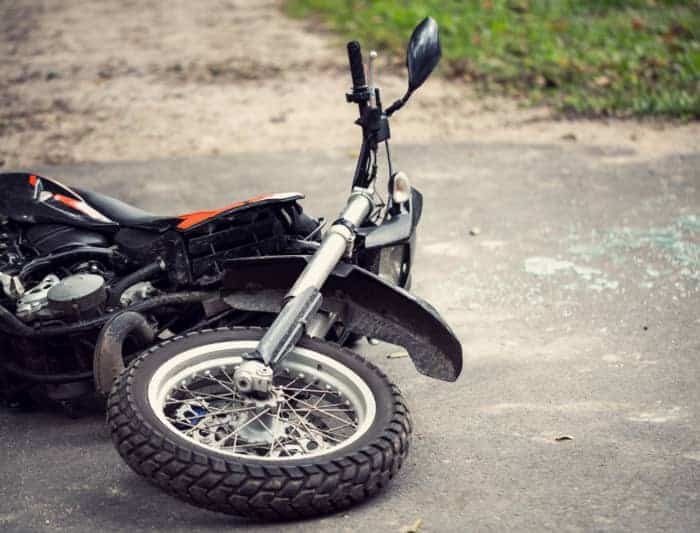
My father-in-law has a saying and I believe it to be very true:
There are two types of motorcyclists. Those who have dropped their motorcycle and those who will drop their motorcycle.
Obviously, try everything you can to prevent that from happening. But even if you try your very hardest, there will be an occasion or two where you will tip your motorcycle. And it’s okay.
If you drop your motorcycle, pick it up immediately and wipe up any fluids that may have leaked. You may have caused some cosmetic damage, but usually no internal damage is done when you drop a motorcycle at low speeds and a short period of time. Brush yourself off as well as your pride if this happens, because you’re in a majority.
Have Basic Tools For Maintenance
If you plan on owning a motorcycle, you should also plan on having some basic tools handy (click here to see my list of recommended tools for motorcycle maintenance). Trust me, having the right tools will save you a lot of money in the long run. Motorcycles are actually fairly simple to work on and are great DIY project candidates.
If you have a little knowledge about how each system works and where each component is, you’ll be way less intimidated and more willing to work on it yourself.
Helmets Have An Expiration Date
Believe it or not, motorcycle helmets have an expiration date. Even if your helmet is not damaged in any way, it is recommended that you replace your helmet every five or so years. You definitely need to replace your helmet if you’ve had some sort of accident, no matter how minimal it was.
After a while, the resins and glues inside the helmet can affect the liner inside. Hair oil and sweat from a person’s head will also add to the degradation. Over time, the padding inside also doesn’t work as well and won’t provide as much protection as it would when it was brand new.
Conclusion
Being new to the motorcycle riding world is very exciting and if you follow these simple rules and tips, your riding experience can be safer and more enhanced. There’s a lot more that goes in to this hobby than simply driving a car, to be sure you’re up to date with your local laws and become familiar with the specific motorcycle you’re riding to ensure your optimal safety.
Good luck with your new endeavors, you’re in for a lot of fun!
Related Questions
How tall do you need to be to ride a motorcycle? There is no specific height that is required to ride a motorcycle, but you will need to at least be able to use your toes and the balls of your feet on both feet simultaneously at a stand-still. Anything less than that, such as tippy-toes or using one foot at a time, is dangerous and increases your risk of tipping over your motorcycle. Click here to see my article for more info.
What are motorcycles made out of? Most older motorcycle frames were made out of tubular steel, whereas now some motorcycle frames are made out of other materials such as carbon fiber and aluminum. Most motorcycle engines are made from aluminum.
